目录
一 、概念
二、使用场景
三、索引使用
四、索引存在问题
五、命中索引问题
六、索引执行原理
一 、概念
索引是一种特殊的文件,包含着对数据表里所有记录的引用指针。暂时可以理解成C语言的指针,文章后面详解


二、使用场景
- 数据量较大,且经常对这些列进行条件查询。
- 该数据库表的插入操作,及对这些列的修改操作频率较低。
- 索引会占用额外的磁盘空间。
三、索引使用
创建主键约束(
PRIMARY KEY
)、唯一约束(
UNIQUE
)、外键约束(
FOREIGN KEY
)时,会自动创建 对应列的索引。
- 查看索引
show index from 表名;- 创建索引
create index 索引名 on 表名(字段名);- 删除索引
drop index 索引名 on 表名;四、索引存在问题
- 索引也会占用一些内存,在表数据量越大越明显
- 索引是可以提高查询速度(前提是要命中索引,后面有解释命中索引),但是可能会拖慢增删改速度。
- 后续如果对数据进行了增删改都要同步索引。
五、命中索引问题
索引命中规则详解:
t这张表 a,b,c 三个字段组成组合索引
select * from t where a=? and b=? and c=? 全命中
select * from t where c=? and b=? and a=? 全命中 解析MySQL的查询优化器会自动调整where子句的条件顺序以使用适合的索引
select * from t where a=? 命中a 解析:最左前缀匹配
select * from t where a=? and b=? 命中a和b 解析:最左前缀匹配
select * from t where a=? or b=? 一个没命中 解析or无法命中
select * from t where a=? and c=? 命中a 解析:最左前缀匹配,中间没有则无法使用索引
select * from t where a=? and b in ( x, y, z) and c=? 全部命中 in精确匹配可以使用索引
select * from t where b=? 一个没命中 解析:最左前缀匹配原则
select * from t where b=? and c=? 一个没命中 解析:最左前缀匹配原则
select * from t where a=? and b like 'xxx%' 命中a和b
select * from t where a=? and b like '%xxx' 命中a
select * from t where a<? and b=? 命中a 解析这个是范围查找
select * from t where a between ? and ? and b=? 命中a和b 解析BETWEEN相当于in操作是精确匹配
select * from t where a between ? and ? and b=? and c and between ? and ? 全部命解析中同上
select * from where a-1=? 函数和表达式无法命中索引
六、索引执行原理
准备测试表
-- 创建用户表
DROP TABLE IF EXISTS test_user;
CREATE TABLE test_user (
id_number INT,
name VARCHAR(20) comment '姓名'
,
age INT comment '年龄'
,
create_time timestamp comment '创建日期'
);
不加索引情况,要是查询大量数据可能死机 :
select * from test_user where id_number=556677;

为提供查询速度,创建 id_number 字段的索引:
create index idx_test_user_id_number on test_user(id_number);
换一个身份证号查询,并比较执行时间:
select * from test_user where id_number=776655;
注意:我们可以看到我们如果查询的是主键,那么索引的值就是我们想要找到的值,如果我们想要获取非主键的值,我们必须根据找到的主键id去原来表中找到非主键,这种操作叫做回表



















